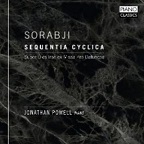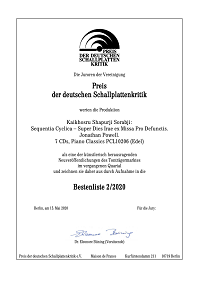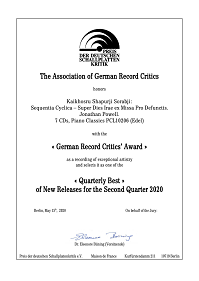Sequentia Cyclica
Jonathan Powell (piano)
Piano Classics: PCL10206 (January 2020)
Web page for Piano ClassicsWeb page for Piano Classics PCL10206
 Duration: 503:48
Comments: PREIS DER DEUTSCHEN SCHALLPLATTEN KRITIK
Duration: 503:48
Comments: PREIS DER DEUTSCHEN SCHALLPLATTEN KRITIK

Track listing
- Track 1-28: Sequentia cyclica super Dies iræ (503:48)
- Track 1: Theme - Largo Legatissimo sempre e nello stile medioevale detto ‘organum’ (4:29)
- Track 2: I. Vivace (spiccato assai) (7:59)
- Track 3: II. Moderato (8:01)
- Track 4: III. Legato, soave e liscio (8:30)
- Track 5: IV. [Tranquillo e piano] (64:45)
- Track 6: V. Ardito, focosamente (8:23)
- Track 7: VI. Vivace e leggiero (3:30)
- Track 8: VII. [L'istesso tempo] (2:27)
- Track 9: VIII. Tempo di Valzer con molta fantasia, disinvoltura e eleganza (20:54)
- Track 10: IX. Capriccioso (11:27)
- Track 11: X. Il tutto in una sonorita piena, dolce, morbida, calda e voluttuosa (33:13)
- Track 12: XI. Vivace e secco (2:19)
- Track 13: XII. Leggiero a capriccio (7:16)
- Track 14: XIII. Aria: Con fantasia e dolcezza (22:16)
- Track 15: XIV. Punta d’organo (26:48)
- Track 16: XV. Hispanica (13:08)
- Track 17: XVI. Marcia funebre (4:34)
- Track 18: XVII. Soave e dolce (3:24)
- Track 19: XVIII. Duro, irato, energico (10:27)
- Track 20: XIX. Quasi Debussy (7:28)
- Track 21: XX. Spiccato, leggiero (3:43)
- Track 22: XXI. Legatissimo, dolce e soave (8:49)
- Track 23: XXII. Passacaglia [with 100 variations] (97:31)
- Track 24: XXIII. Con brio (12:21)
- Track 25: XXIV. Oscuro, sordo (10:47)
- Track 26: XXV. Sotto voce, scorrevole (2:16)
- Track 27: XXVI. Largamente pomposo e maestoso (16:24)
- Track 28: XXVII. Fuga quintuplice a due, tre, quattro, cinque e sei voci ed a cinque soggetti (79:58)
Reviews
- “‘Because it’s there’ was George Mallory’s response as to why he was climbing Everest, yet it might equally apply to any pianist who attempts one of the numerous epics by Kaikhosru Sorabji. Not least Jonathan Powell, whose dedication to this composer has now extended to Sequentia cyclica super Dies irae ex Missa pro defunctis, which, at nearly eight and a half hours, makes the once infamous Opus clavicembalisticum a rather middling Himalayan peak even if, given the likely even longer Symphonic Variations, it is still only Sorabji’s K2.
Written between the end of 1947 and April 1949, with a dedication to Egon Petri, Sequentia cyclica was partly a response to an earlier set of variations on ‘Dies irae’ with which Sorabji had become dissatisfied. Not so this work, which he regarded as his greatest achievement up until his death almost four decades later. The present endeavour is the result of an 18-month process when the 335-page score was concurrently typeset and learnt, culminating with the first complete public performance in Glasgow on June 18, 2010. Several more have followed, including one in Oxford prior to this recording. The outcome is a formidable test of stamina even for sympathetic listeners – but there is no reason why anyone predisposed should avoid acquaintance with music so dense and multifaceted yet, for the most part, highly absorbing.
[...]
It remains to add that, throughout its epic entirety, Powell is a dedicated as well as perceptive exponent. He leaves nothing to chance technically, while also going further than any other of Sorabji’s advocates in conveying an experience that, whatever its transcendental (and not a little self-regarding) virtuosity, is undeniably informed with the desire to communicate. His Steinway D is well served by Piano Classics’ wide-ranging if occasionally unyielding sound, while Powell’s annotations provide both a detailed introduction and in-depth listening guide.
Whether or not Sequentia cyclica is Sorabji’s defining masterpiece (and the are some comparable epics that are still unheard), it is likely to remain his most inclusive and revealing major statement: a wilful yet engrossing challenge that, in Powell, has met its match.” (Gramophone) - “Sequentia Cyclica is unquestionably one of Sorabji’s greatest and most significant works (he regarded it as one of his best). It was his final work of the 1940s, a fertile decade that also produced the enormous set of Transcendental Studies; his nocturne to end all nocturnes, Gulistān; the M.R.James ghost story pieces; and the astonishing Concerto per suonare da me solo. Twenty-seven (3 cubed) variations on the Dies irae - (that description alone makes it a tantalizing prospect, doesn’t it?) - Sorabji clearly relished pouring the best and most characteristic of himself into his colossal elaboration of Tommaso di Celano’s great plainchant melody. Outstanding examples of many of his favorite forms are here, several of which could easily function as self-contained works in their own right - the large Chorale Prelude, the exquisite Aria, the Gulistān-esque Nocturne, the colossal Passacaglia (with 100 variations of its own!) for instance. Shorter movements of specific character - a Waltz, “Quasi Debussy” (yes, really!), a funeral march and variations in various textures and techniques recall key pieces from the 100 Transcendental Studies, and of course the work is crowned with a massive (quintuple) Fugue and Coda stretta. There is transcendental virtuosity aplenty, naturally, but also many passages of sheer, exotic beauty, what Ronald Stevenson (describing another Sorabji work) called ‘Oriental stasis and calm’, and Sorabji’s unique textures, the whole governed by an astonishing sense of large-scale structure.” (Records International)
- “[...]Sorabji was inspired by Late Romantic modernism, especially Busoni and the perfumed exoticism of Szymanowski. He dedicated Sequentia Cyclica to Busoni disciple Egon Petri. The music’s structures are Baroque, but its tonality is both free and complex. Impressionistic colour is especially apparent in such movements as ‘Hispanica’ (XV) with its ornate Latin rhythms, and the delightful pastiche ‘Quasi Debussy’ (XIX). The score is overloaded with ornamentation and calls for extreme virtuosity, yet in this remarkable new recording by Jonathan Powell, it seems to express a deep mysticism. It’s tempting to argue, given the composer’s background, that Sorabji transferred something of the meditative aesthetic of Indian ragas to the Western classical piano.
Anyone who plays Sorabji has to be an aficionado because of the challenges involved. Powell certainly qualifies for this description. In addition to performances of Opus Clavicembalisticum – by comparison, at five hours, almost a repertoire work – Powell has given several public performances of Sequentia Cyclica. He is a passionate, immensely able advocate, and never allows Sorabji’s giganticism to tip over into excess or hysteria.[...]” (International Piano) - “Es ist schon an sich erstaunlich, dass sich ein Label wie Piano Classics jetzt einem so extremen Außenseiter wie dem englischen Komponisten Kaikhosru Shapurji Sorabji (1892-1988) zuwendet; und dazu noch gleich mit einem Klavierwerk, das fast 8½ Stunden dauert. Was hier vorgelegt wird, ist die erste und in jeder Hinsicht gelungene Auseinandersetzung mit einem der komplexesten Klavierwerke der Musikgeschichte.
[...]
Der britische Pianist Jonathan Powell setzt sich schon lange für weniger bekannte Klaviermusik, besonders russische zu Beginn des 20. Jahrhunderts, ein und ist ein gefragter Uraufführungsinterpret. Für Sorabji hat sich Powell sehr früh interessiert – bereits seine Darbietungen der 1. Klaviersonate erreichten mindestens das gleiche Niveau wie Marc-André Hamelins legendäre CD-Einspielung. Powell hat dann insgesamt 9 CDs mit Sorabji-Werken beim hierzulande schwer erhältlichen Altarus-Label aufgenommen – zumeist Ersteinspielungen. Opus Clavicembalisticum und die Sequentia cyclica hat Powell mehrfach am Stück gespielt, letztere uraufgeführt – ein unbegreiflicher Kraftakt! Dass das auch fürs Publikum anstrengend ist, durfte der Rezensent bei der gleichermaßen genialen Wiedergabe von Sorabjis zweiter Orgelsymphonie – über 8 Stunden netto – durch Kevin Bowyer 2019 in der Elbphilharmonie erfahren. Um die durch Powell fantastisch herausgearbeiteten Feinheiten der 27 Variationen wirklich zu genießen, sollte sich der Hörer also eher Zeit nehmen – hier ein wirklicher Vorteil der Tonkonserve. Erst beim wiederholten Hören erschließt sich die oft unglaubliche klangliche Schönheit, die der Pianist ans Tageslicht fördert: Sein Anschlag wird selbst bei den Höhepunkten nie grob, obwohl Architektur und die überdimensionalen Steigerungen kompromisslos ernst genommen werden. Wie niemand sonst bewältigt Powell den intrikaten Klaviersatz scheinbar mühelos, dabei mit verblüffender Präzision: Mehr als die schiere Notenmasse wird die Polyrhythmik zwischen den einzelnen Stimmen schnell zur echten Herausforderung. Die enorme dynamische Kontrolle, gerade in der Schlussfuge, die nötig ist, um das Ganze völlig durchhörbar zu machen, ist am Klavier naturgemäß noch schwieriger als auf der Orgel und gelingt hier absolut staunenswert. Die vielen unterschiedlichen Charaktere, zu denen das Dies irae hier mutiert, trifft Powell stets auf den Punkt und mit entsprechendem historischem Verständnis.
Das Booklet enthält einen großartigen 37-seitigen, musikwissenschaftlichen Essay Powells, der dem Hörer ohne Partitur Struktur und Eigenheiten jedes Abschnitts detailliert näherbringt. [...]” (Klassik Heute) - “British virtuoso composer/pianist Jonathan Powell has been playing Sorabji for years: As a specialist in Busoni, Szymanowski and Scriabin, it was inevitable his interest would alight on a composer strongly influenced by all three.
Sequentia Cyclica (1948/49) requires seven discs and lasts for over eight hours. The theme is presented as a cantus firmus to begin with, but undergoes metamorphosis into a waltz, a funeral march, a Spanish dance, and more. The largest variations are major creations in themselves: No 10 is a shimmering Fantasia, mesmerising in its cumulative effect; No 22 is a massive Passacaglia containing one hundred variations of its own, and the final Variation No 27 is a multiple fugue lasting 41 minutes. The 27-minute Variation 14, titled “Punta d’organo”, unfolding over a single note, sounds like a supernaturally expanded and magnified meditation on Le Gibet from Ravel’s Gaspard de la Nuit. While Powell has presented the entire cycle in one concert (!), I would recommend the listener dip into it to discover this unique, exotic masterpiece: occasionally abrasive, often voluptuous, overflowing with musical ideas, and performed with extraordinary skill and sensitivity.” (Limelight Magazine) - “[...]
Noteworthy among these interpreters is the English pianist Jonathan Powell, who has championed the composer for over two decades. He has taken a number of Sorabji’s works in manuscript and transcribed them into performing editions, toured them widely, and begun the challenging task of creating recorded documentation of the piano oeuvre. His most recent project has been Sequentia Cyclica, a piece lasting nearly eight hours that he has presented in marathon single-day concerts in the United Kingdom, Europe, and the United States. Piano Classics has released a seven-CD boxed set of Powell’s rendition of the piece. It is an extraordinary recording of a totemic work.
[...]
Jonathan Powell’s traversal of Sequentia Cyclica is authoritative. The program notes are some of the finest I have read in a long while. His performance is deftly nuanced, technically assured, and powerfully rendered. It is a benchmark that will provide a tough act for future interpreters to follow, but hopefully his performance editions will encourage them to do so regardless. Powell’s dedicated work on behalf of Sorabji makes the composer’s legacy seem assured. ” (Sequenza21) - “Sorabji’s Sequentia Cyclica, Super Dies Irae ex Missa Pro Defunctis, monumental in size and complexity, makes his Opus clavicembalisticum seem like a mere entrée. The Sorabji Archive’s approximate duration of the former’s 260 manuscript pages clocks in at just over four and a half hours. Jonathan Powell’s exploration of Sequentia Cyclica is almost twice that length in this, the world premiere recording that stretches over seven CDs. Sorabji thought it his best work for piano.[...]
Jonathan Powell gave the world premiere of the work in Glasgow in 2010. He has also written the extensive booklet notes which contextualise and itemise Sorabji’s achievement. The recording is a touch on the cool side but any lack of reverberance is hugely outweighed by Powell’s technically remarkable, idiomatically perceptive performance. The recording took six days in total to complete and at the end one has, in a handy box, a massive work performed with unremittingly massive conviction.” (MusicWeb International) - “[...]Powell clearly has the mood and color of Sorabji down pat from the opening of the Theme.
[...]
And believe me, as this cycle continues, super-virtuosity becomes important. Immediately after the theme we get a “Vivace” that calls for almost superhuman digital dexterity, and here Powell is also up to the task. [...]
This is a monumental achievement that may never be duplicated on records ever again, and he deserves all the credit in the world for having convinced Piano Classics to let him record it.” (Art Music Lounge)
